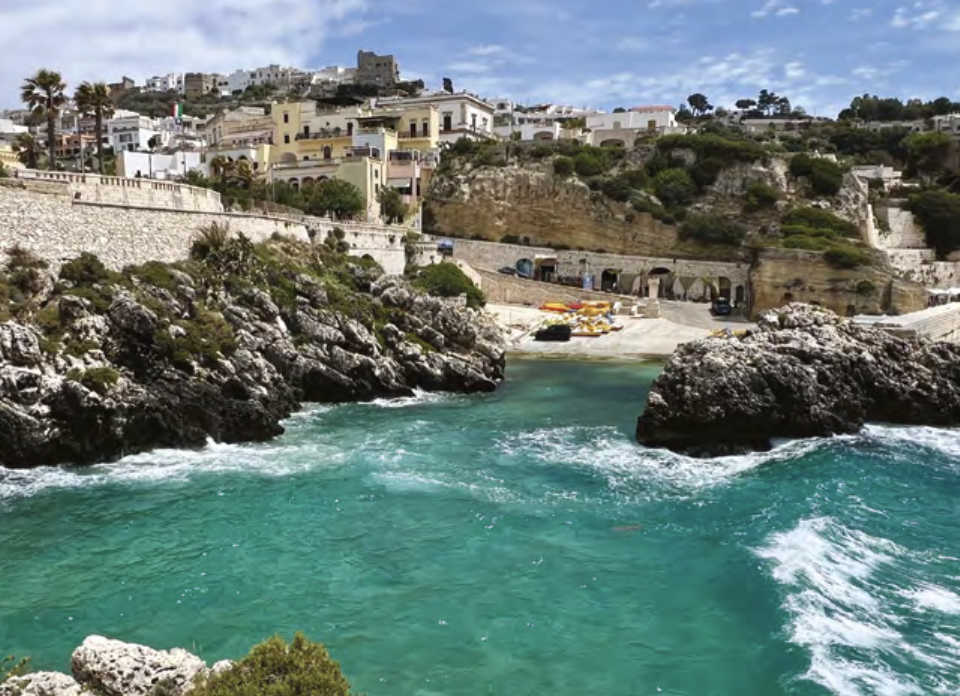By Gary Lawrence
From thousand-year-old olive trees to inviting beaches, from fishing villages to walled cities, Puglia—the heel of Italy’s “boot”—displays its charms beneath the Mediterranean sun with the Adriatic Sea along its northern coast and the Ionian Sea to the south. Here are just a few of the highlights.
Enchanting Alberobello
While exploring the fascinating (and very busy) village of Alberobello, a UNESCO World Heritage Site, you may feel that you’ve landed on the set of some fantastic film. Everywhere you look are clusters of trulli—small circular limestone dwellings with roofs shaped like conical elves’ hats.
In the 15th century, people could quickly disassemble (and later re- assemble) these drystone homes to avoid paying property taxes when there was an inspection. Today, some of these 1,500 trulli are lived in while others are hotels, shops, bars, and restaurants. Try a Primitivo or a Negroamaro (local wines) or some Orecchiette alla Pugliese, the earshaped pasta that is the region’s signature dish, or spend the night dreaming of fairy tales.
Ostuni: The White City
Is it an Arabian casbah, a Greek city, or an Andalusian village? Ostuni is in fact a bit of each, but above all it’s a stunning Italian city built on various levels on three hills. Known as The White City, Ostuni dazzles on every side, whether you roam its winding streets and hidden alleys or admire it from afar, brightly glittering against the backdrop of the Adriatic Sea. In the evening, Ostuni is bathed in light, first at sunset and then in the glow of its streetlights, while its terraces fill with foodies in search of pasta with sea urchins or grilled octopus. Whatever the time, day or night, Ostuni entices you to endless explora- tion and offers excitement at every turn.
Golden Otranto
When you enter Otranto Cathedral, the nave floor covered with 12th-century mosaics will amaze you, but it’s still not as striking as the Chapel of the Martyrs. The chapel makes you realize why this city is so well fortified: the highly visible skulls of 813 Christians beheaded by the Ottomans are a reminder that, for centuries, an enemy lurked along the coasts. Today, Otranto’s beauty shines through, with its high light-ochre ramparts that encircle its historic centre, its imposing Castello Aragonese, and the medieval frescoes of its small Chiesa di San Pietro (Church of St. Peter). And in good weather, from the top of its walls, it’s no longer the enemy that you can see in the distance but the high peaks of Albania, on the other side of the Adriatic.
Gallipoli the Beautiful
Ideally, you’ll arrive in Gallipoli at the end of the day, when the Puglians begin to stroll along the lungomare, the seaside promenade perched on the ramparts. As the sun begins to set, the vibe becomes more relaxed and children play while their parents enjoy a popular wine-based Italian cocktail known as a spritz. Then, the lanes are lit up and the servers’ ballet begins be- tween the restaurant kitchens and the tables set up in the open air. Nicknamed Kalè Polis (“the beautiful city”) by the Greeks, Gallipoli at times seems to float on the turquoise waters of the Ionian Sea. Beyond its Angevin fortress, surrounded by fishing boats that bob below, its centro storico (old town) is nothing but sweetness, just like its way of life. Late in the evening, the city empties, partly because its residents (and visitors) head to the nearby beaches, which become outdoor nightclubs.
Matera: The Ancient City
Although it’s found in the neighbouring Basilicata region, it is so near— and so exceptional—that it shouldn’t be missed: a UNESCO World Heritage Site, Matera is one of humanity’s oldest cities. In the paleolithic age (10,000 or more years ago), men and women were already taking refuge in the countless sassi (cave dwellings) in its two valleys; some people still live in the sassi today. Now teeming with life and studded with attractions including museums, rock-hewn churches, and a vast underground cistern—the Palombaro Lungo—Matera takes us so far back in history that Mel Gibson’s The Passion of the Christ was filmed there. It also played a starring role in the opening scene of the most recent James Bond film, No Time to Die. Don’t wait to visit Matera—there’s no time to lose!
Lecce: The Florence of the South
Renowned for its papier-mâché sculptures and its pasticciotti—decadent cream-filled pastries—Lecce is even better known for the network of alleys and squares that form the framework of the old city. A Baroque gem, the “Florence of the South” shines even more brightly because of its incredible collection of palaces, public squares, courtyards, and 40 or so churches, including the sublime Chiesa Santa Croce. The finely chiselled facade of this masterpiece features a strange phantasmagoric bestiary and the quintessential Baroque Lecce style. The city’s charm stems largely from the beauty of the pierra leccese used for its buildings: this soft limestone is easy to sculpt and tends to bleach over time. In the evening, Lecce becomes a huge theatrical arcade thanks to the subtle lighting of the facades. And whether it’s at the foot of the belltower of the Piazza del Duomo or by the ruins of the Roman amphitheatre, you can sense all the energy of this exuberant city, with its light-filled walls and age-old soul.
For more information: viaggiareinpuglia.it/en






